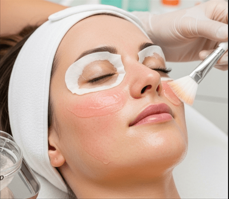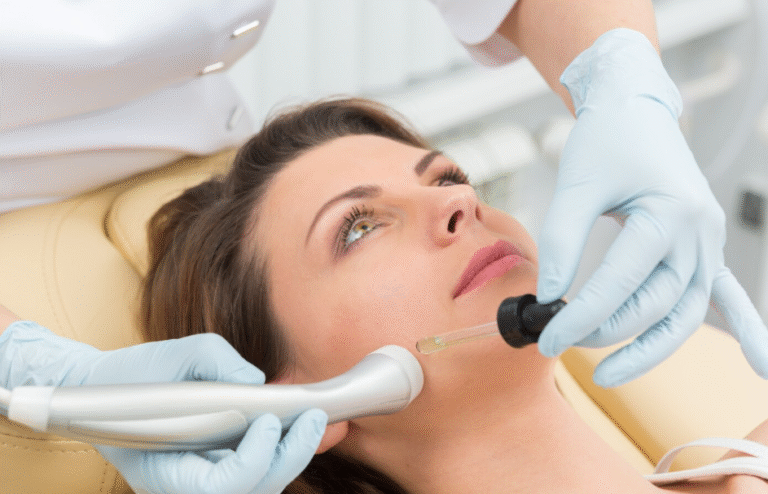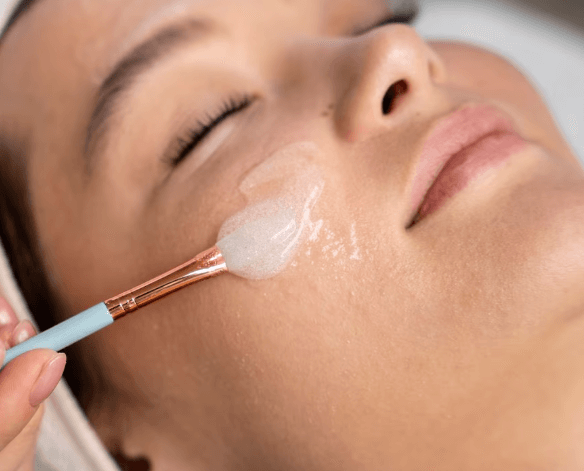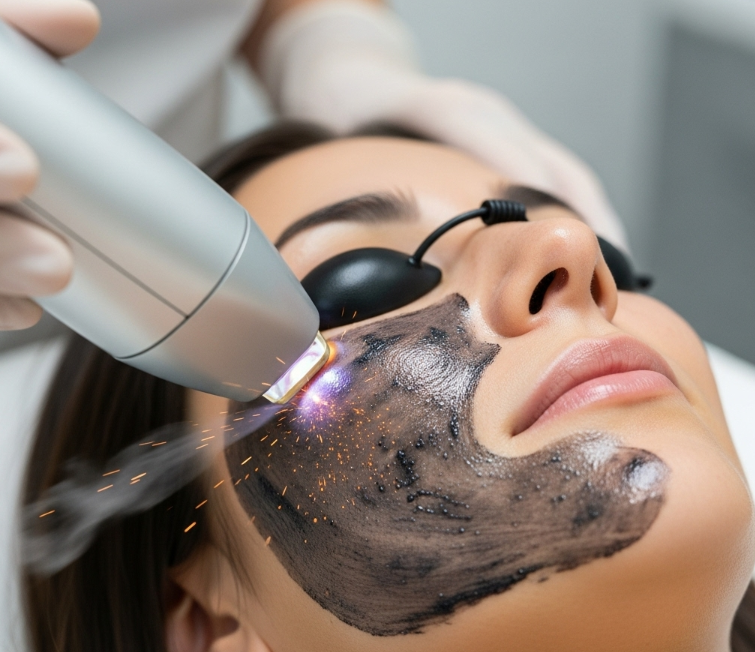Treatment Overview
The Glycolic Acid Peel is one of the most widely used chemical peels in Korean dermatology for melasma and hyperpigmentation. Derived from sugarcane, glycolic acid is an alpha hydroxy acid (AHA) with a small molecular size, allowing it to penetrate effectively into the skin. It works by exfoliating pigmented cells, stimulating cell turnover, and enhancing penetration of brightening agents.
In Korea, dermatologists adapt glycolic acid peels to low-to-medium concentrations (20–50%) and combine them with hydration therapy, brightening infusions, or tranexamic acid mesotherapy to minimize irritation and maximize pigment control.
For melasma, Glycolic Acid Peel:
- Exfoliates surface pigmentation gradually.
- Promotes cell renewal for clearer, brighter skin.
- Improves absorption of topical melasma treatments.
- Supports combination therapy protocols for stable outcomes.
Purpose & Benefits
- Exfoliation of Pigmented Cells: Removes damaged keratinocytes carrying excess melanin.
- Even Skin Tone: Smooths discoloration and improves skin brightness.
- Enhanced Product Absorption: Prepares skin for infusions (Vitamin C, tranexamic acid).
- Collagen Stimulation: Boosts skin renewal and texture improvement.
- Affordable & Effective: A widely available option in Korean dermatology clinics.
- Synergy with Other Therapies: Often combined with lasers or brightening serums.
Ideal Candidates
The Glycolic Acid Peel in Korea is recommended for:
- Patients with epidermal or mild mixed-type melasma.
- Individuals with dull, rough, or uneven skin tone.
- Adults seeking budget-friendly pigmentation management.
- Patients preparing for or recovering from laser treatments.
- Those requiring maintenance therapy after melasma improvement.
Comparison with Other Treatments
- Glycolic Acid Peel: Best for exfoliation and superficial pigmentation.
- Botanical Whitening Peel: Gentler, plant-based alternative for sensitive skin.
- Fractional Thulium Laser: Deeper resurfacing and drug delivery.
- Dual Toning Laser: Stronger control of mixed melasma (surface + deep).
- Ferulic Acid Infusion: Antioxidant-focused pigment prevention.
Possible Risks & Complications
While generally safe under professional care, glycolic acid peels may cause:
- Temporary Redness or Tingling: Common during and after treatment.
- Mild Peeling or Flaking: Normal exfoliation response.
- Dryness or Sensitivity: Managed with moisturizers.
- Post-Inflammatory Hyperpigmentation (PIH): Rare, reduced with low-fluence protocols in Korea.
Treatment Techniques Used
- Low-to-Medium Concentration Peels (20–50%): Applied evenly on skin for controlled exfoliation.
- Customized Application Times: Shorter contact time for sensitive or melasma-prone skin.
- Neutralization: Peel neutralized with soothing solutions.
- Combination Therapy: Often paired with brightening infusions, Aqua Peel, or tranexamic acid.
- Session Protocol: 4–6 sessions, spaced 3–4 weeks apart.
Recovery & Aftercare
- Immediately: Mild redness and tingling possible.
- 1–3 Days: Gentle peeling or flaking as pigmentation sheds.
- Weeks of Consistency: Brighter, smoother skin tone with reduced melasma spots.
Aftercare Tips:
- Apply soothing creams and hydrating serums daily.
- Avoid direct sun exposure for at least 1 week.
- Use SPF 50+ sunscreen strictly.
- Avoid retinoids, scrubs, or other strong acids for 5–7 days.
Results & Longevity
- Short-Term (1–2 Sessions): Skin looks fresher and more radiant.
- Medium-Term (3–4 Sessions): Gradual fading of surface melasma patches.
- Long-Term: Maintenance peels every 2–3 months recommended to prevent recurrence.
Treatment Process in Korea
- Consultation & Skin Assessment – Doctor evaluates melasma severity and skin type.
- Preparation – Cleansing and optional hydration prep.
- Peel Application – Glycolic acid solution applied for a few minutes.
- Neutralization & Rinse – Peel neutralized and removed.
- Post-Care – Cooling mask, hydrating serum, and sunscreen applied.
- Follow-Up – Sessions repeated monthly for best results.
Why Korea is a Top Destination
- Korean dermatologists adapt glycolic peels with low-irritation protocols for melasma patients.
- Clinics combine peels with brightening infusions for enhanced outcomes.
- Packages are affordable and widely available compared to Western dermatology.
- Multi-step Korean skincare approach integrates peels into holistic melasma programs.
- Seoul is a leader in chemical peel innovations and safety techniques.
Cost Range (Detailed Breakdown)
Pricing for Glycolic Acid Peel in Korea for melasma:
- Single Session: USD 80 – 150
- 3–5 Session Package: USD 250 – 600
- Glycolic Peel + Brightening Infusion (Vitamin C/Tranexamic Acid): USD 180 – 350 per session
- Premium Melasma Package (Glycolic Peel + Laser + Infusions): USD 1,200 – 2,500 (4–6 sessions)
Additional Costs in Korea:
- Consultation: USD 20 – 40
- Add-ons (Glutathione, Ferulic Acid, Aqua Peel, PRP): USD 150 – 500
💡 Patients often call Glycolic Acid Peel the “classic resurfacing peel” for melasma, thanks to its affordability, accessibility, and effective pigment control.
Popular Clinics in Seoul
- Oracle Dermatology – Glycolic peel with laser toning programs.
- Banobagi Dermatology – Customized peel + tranexamic acid infusion.
- Renewme Skin Clinic – Glycolic peels paired with antioxidant therapies.
- View Plastic & Dermatology – Multi-step melasma care with peel + laser combos.
- Chaum Anti-Aging Center – Luxury chemical peel programs with whitening boosters.




